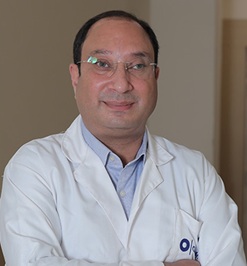PCL Reconstruction Surgery: Procedure, Benefits, Recovery

Treatment Duration
30 Minutes
------ To ------45 Minutes
Treatment Cost
₹ 45,000
------ To ------₹ 2,00,000

Table of Contents
- What is PCL Reconstruction Surgery?
- What are the Benefits of the PCL Reconstruction Surgery?
- Who needs PCL Reconstruction Surgery?
- How is PCL Reconstruction Surgery Performed?
- What to Expect Before the PCL Reconstruction Surgery?
- What to Expect On the Day of PCL Reconstruction Surgery?
- What to Expect During the PCL Reconstruction Surgery?
- What is Recovery and Post Op. Care After PCL Reconstruction Surgery?
- First Follow-up Appointment
- What are Risks and Complications of PCL Reconstruction Surgery?
You can check PCL Reconstruction Surgery Cost here.
What is PCL Reconstruction Surgery?
PCL, or the posterior cruciate ligament, is the strongest ligament in the knee joint. This is why PCL injuries are less common when compared to ACL (anterior cruciate ligament) injuries. A PCL injury is sometimes referred to as an ‘overextended injury’ because, during the injury, a person’s knee bends in the wrong way, causing damage to the nearby ligaments near the knee. This is also known as knee hyperextension.
A PCL injury can cause a stretch or tear of the ligament. If the injury is not too severe, it can heal on its own using conservative treatments such as giving adequate rest, applying ice, using compression bandages, etc. But if the ligament is severely damaged, surgery would be needed, in which the damaged ligament is replaced with new tissue.
PCL Reconstruction Surgery Videos by HexaHealth
Expert Doctors (10)
NABH Accredited Hospitals (10)


What are the Benefits of the PCL Reconstruction Surgery?
A PCL injury affects a person's quality of life, whether a working professional or an athlete. So, the main objective of the PCL reconstruction is to restore knee stability so that the person can return to the preinjury activity level. It also helps improve the knee's functioning and prevents any further damage to the ligament in the future. The average success rate of a PCL surgery is reported to be approximately 85 per cent.
Who needs PCL Reconstruction Surgery?
A PCL injury is more common among athletes who play contact sports such as Kabbadi, Football, Basketball, or other sports where the player needs to jump and land on his/her knee. But it is not just limited to athletes only. Any movement that causes intense pressure on the posterior knee can result in a PCL injury.
It may also occur when the ligament suffers many injuries, which can become more dangerous over time if it remains untreated. With time the ligament will wear down and degenerate, causing a severe tear that can limit the activities and movements of an individual, leading to persistent dysfunction.
Surgery is often recommended in the case of a complete tear of the PCL along with damage to the surrounding ligaments or if the knee has become critically unstable.
Patients with grade 2 PCL tears also need to consider PCL reconstruction if they experience pain in the following conditions:-
- Deceleration
- Going down inclines
- Going down a hill
- Knee cap pain
- Pain along the inside (medial joint line) of the knee
Chiefly, the PCL injury can be divided into three grades:
Grade 1: Partial or microscopic tear of the fibre of the ligament due to extension. It can also be referred to as a sprain.
Grade 2: Slight instability in the knee joint along with a partial tear of the ligament fibres.
Grade 3: A complete PCL tear causing significant instability in the knee joint.
How is PCL Reconstruction Surgery Performed?
During a PCL reconstruction, the surgeon removes the torn ligament and reconstructs it with the tissue taken from another part of the patient’s body (autograft) or a human donor (allograft). The graft can take several months to heal completely. The surgeon follows a minimally invasive arthroscopic procedure for the reconstruction. In this procedure, small cuts are made on the surgical site, and an arthroscope is inserted inside the knee to remove and replace the damaged part.
What to Expect Before the PCL Reconstruction Surgery?
Physical Examination
- A doctor physically examines the patient to check the severity of the injury.
- The most common test performed by the doctor is the Posterior Drawer test.
- In this test, the patient’s knee is bent at 80-90 degrees, and the doctor applies posterior translation stress at the knee (slightly pushing the knee backwards) to determine the strength of the PCL.
- If the doctor feels an increase in the translation (more than 10 mm), he/she may recommend surgery.
- For more accurate injury identification, imaging procedures can also be done, including an MRI or an X-ray.
- Other tests may include: observing Sag sign, Active Quadriceps test, etc.
In case of surgery,
- The patient needs to inform the doctor about all the medicines, including the non-prescriptive medicines such as Aspirin, he/she has been taking.
- The doctor provides instructions regarding which medicines to continue or avoid before the surgery.
- He/she also provides details regarding the surgical procedure.
- If required, the patient receives instructions regarding fasting (after midnight) a day before the surgery.
- The doctor advises a pre-anaesthesia checkup and other diagnostic tests based on the patient’s medical history.
- The surgery usually takes between 45 minutes and 2 hours depending on its complexity.
What to Expect On the Day of PCL Reconstruction Surgery?
- After checking in at the hospital, the patient first signs the consent forms.
- The patient is then made to change into a hospital gown.
- The healthcare providers monitor the patient’s vitals to examine the heart rate, blood pressure, and oxygen level and transfer the patient to the OT room.
- The surgical site might be shaved.
What to Expect During the PCL Reconstruction Surgery?
- The anaesthesiologist induces general or local anaesthesia so that the patient doesn’t feel any pain during the surgery.
- An IV (intravenous) line is started in the patient’s arm or hand.
- Healthcare providers monitor the patient’s vitals before the surgery.
- After cleansing the knee area with an antiseptic solution, the surgeon makes small incisions.
- The surgeon uses an arthroscope to reconstruct the PCL.
- An arthroscope is a narrow tube-like instrument inserted inside the incisions. The instrument has a camera on one of its ends to provide a clear view of the surgical site.
- The injured tendon is removed, and the surgeon prepares an autograft (tissue) from the patient's thigh or lower leg bones. (In most cases, a hamstring tendon (present behind the knee) is used to prepare the graft to replace the injured tendon. Sometimes peroneus tendon (located in the ankle) may also be used.)
- The graft may also come from a human donor (allograft).
- The surgeon first drills small holes in the tibia and femur where the torn ligament was attached.
- The surgeon then connects the graft on the femur using an endobutton and on the tibia through screw fixation to reconstruct PCL.
- After the surgery is complete, he/she closes the incisions with the help of sutures and stitches.
- A sterile bandage or dressing is applied.
What is Recovery and Post Op. Care After PCL Reconstruction Surgery?
After the Surgery
- The patient is transferred to a recovery room where he/she is kept under observation to check the vitals and the effect of the anaesthesia.
- The healthcare providers give pain-relieving medicines to ease the pain after surgery.
- PCL reconstruction is an outpatient surgery which means that the patient is allowed to go home once his/her condition is stabilised.
- The patient may be given crutches and a knee immobiliser before going home.
- He/she is also given specific instructions regarding diet, leg movement, etc.
At Home
- The patient must keep the stitches covered.
- The doctors may wrap a compression bandage on the knee to prevent swelling. The patient can remove it after 48 hours of the surgery.
- He/she must wear knee braces to ensure proper healing as unlike the ACL, the PCL lacks the ability to heal.
- Only partial weight-bearing through the knee is permitted for the first four weeks after the surgery. So, if the patient is given crutches, he/she must ensure their use to maintain balance.
Restrictions
- The patient should not remove the knee brace unless told by the doctor or physiotherapist (the brace can be removed while taking a shower or changing clothes)
- He/she must follow proper bathing instructions to prevent water from hitting the wounds to keep the surgical area clean and dry.
- The patient should avoid using blood-thinning medicines (like Aspirin) to relieve pain. Such medicines may increase the chance of bleeding.
First Follow-up Appointment
The patient needs to visit the doctor for regular checkups as instructed. During the first follow-up appointment, the doctor removes sutures or stitches and monitors the patient’s recovery to give follow-up instructions.
Recovery
- The patient must do physiotherapy and rehabilitation exercises (as suggested by the doctor) till complete recovery.
- It may take six months to recover fully.
What are Risks and Complications of PCL Reconstruction Surgery?
The following risks and complications are involved in PCL reconstruction:-
- Bleeding from the incisions
- Post-surgical infection
- Allergic reaction to anaesthesia
- Blood clots in the legs and lungs
When to Consult a Doctor?
The patient must consult the doctor if they notice any of the following symptoms:-
- Chills or fever over 100°F
- Drainage from the incisions
- Redness and swelling around the wound
- Increased pain around the incision site
More Treatment options
Last Updated on: 24 June 2022
Author
HexaHealth Care Team
HexaHealth Care Team brings you medical content covering many important conditions, procedures falling under different medical specialities. The content published is thoroughly reviewed by our panel of qualified doctors for its accuracy and relevance.
























